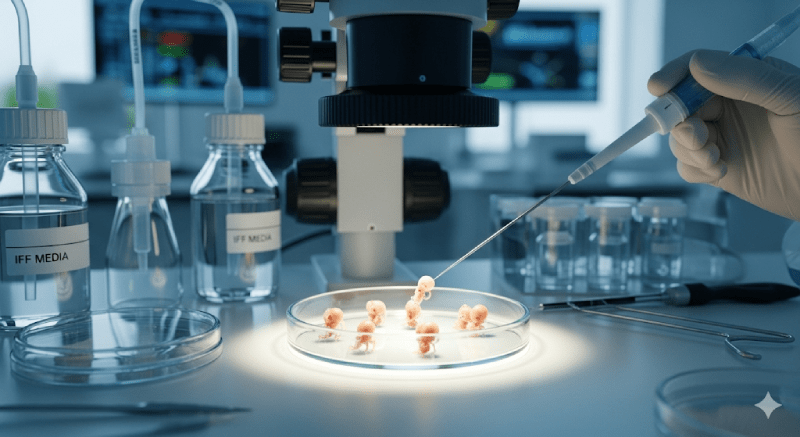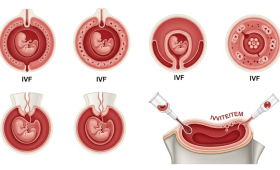In vitro fertilization (IVF) is a sophisticated and widely used medical procedure designed to address infertility. However, despite its advancements, IVF cycles frequently fail to result in a live birth, a reality that presents a significant challenge for both patients and clinicians. The analysis reveals that IVF failure is not a singular event but a complex interplay of three primary pillars: the quality and viability of the embryo, the receptivity and health of the uterine environment, and the precision of the clinical and laboratory procedures.
The most common reason for a failed cycle is poor embryo quality, often stemming from chromosomal abnormalities that increase with maternal age. This factor alone accounts for a substantial percentage of implantation failures. The uterine lining must be structurally and hormonally prepared to accept the embryo; issues such as a thin lining, polyps, or fibroids can compromise this process. Finally, the technical skill of the medical team and the meticulous environmental controls within the IVF laboratory are foundational to success.
This report synthesizes evidence from various clinical and research sources to provide a comprehensive framework for understanding the causes of IVF failure. It moves beyond a simple list of problems to explain the biological and technical mechanisms at play, highlighting advanced diagnostic tools such as Preimplantation Genetic Testing (PGT) and the Endometrial Receptivity Array (ERA) test. The report also addresses the critical patient-centric factors, including lifestyle optimization and the psychological support necessary to navigate this challenging journey. The information herein is intended to empower patients with knowledge and provide clinicians with a holistic perspective for developing a more effective, personalized treatment plan following an unsuccessful cycle.
| Category | Specific Factor | Evidence/Data Points | Diagnostic Tools | Interventions/Strategies |
| Embryo | Chromosomal abnormalities | Most common cause of failure; increases with maternal age; up to 75% of embryos may be abnormal in women over 45. | Preimplantation Genetic Testing (PGT), Embryoscope (Time-lapse imaging). | Donor eggs, Assisted hatching, Change of treatment protocol. |
| Poor morphology | Embryos may appear healthy but have an “invisible defect” that prevents implantation. | Embryo grading system (e.g., 5AA), Embryoscope. | Advanced lab techniques, Embryo selection protocols. | |
| Uterine | Endometrial receptivity | Lining must be ≥7-8mm and trilaminar; thin lining associated with lower pregnancy rates. | Endometrial Receptivity Array (ERA), Ultrasound. | Supplemental estrogen, Blood flow improvement, Antibiotics for infection. |
| Anatomical issues | Fibroids, polyps, adhesions can hinder implantation. | Hysteroscopy, Transvaginal ultrasound. | Surgical removal of fibroids or polyps, Hysteroscopic treatment of adhesions. | |
| Technical/Clinical | Lab environment | Precise control of temperature, gases, and pH is critical; slight alterations can lead to embryo death. | Key Performance Indicators (KPIs), Accreditation. | Change of clinic to one with a proven track record, Meticulous quality control protocols. |
| Embryo transfer technique | Must be a precise procedure; traumatic transfers can affect the uterine cavity. | Ultrasound guidance. | Ensure the procedure is performed by an experienced specialist. | |
| Patient-Related | Maternal age | The single most important factor affecting success rates; declines sharply after age 35. | Blood tests (FSH, AMH). | Use of donor eggs, PGT-A. |
| Lifestyle factors | Obesity, smoking, and alcohol reduce IVF success rates. | BMI assessment, consultation. | Maintain a healthy weight, quit smoking/drinking, reduce caffeine, adopt a nutrient-rich diet. |
Introduction: Understanding the IVF Journey and the Challenge of Failure
In vitro fertilization (IVF) has revolutionized the treatment of infertility, offering hope to countless individuals and couples seeking to start a family. Despite its widespread application and technological advancements, the journey is often fraught with challenges, and a significant number of IVF cycles do not result in a successful pregnancy. The success of an IVF cycle is highly variable and depends on a complex web of factors that are often interconnected. Data from the Centers for Disease Control and Prevention (CDC) suggests that the average IVF success rate in the U.S. is approximately 48.12% per embryo transfer, while other sources report clinical pregnancy rates ranging from 40-50% for women under 35. These statistics underscore that while IVF is a valuable tool, a successful outcome is not a certainty.
The objective of this report is to provide a comprehensive, evidence-based analysis of the primary factors contributing to IVF failure. By dissecting the underlying biological, clinical, and patient-specific elements, this report aims to offer a nuanced understanding that goes beyond simple explanations. It will address the most common and often unspoken question from patients: “Why didn’t the embryos stick?” The report will demonstrate that the reasons are rarely due to a single, isolated problem, but rather a dynamic interplay between the embryo, the uterus, and the clinical process itself.

Chapter 1: The Foundational Role of Gamete and Embryo Quality
The viability of the embryo is the single most important determinant of IVF success. While the uterine environment and technical procedures are critical, the inherent quality of the embryo is the ultimate arbiter of whether implantation will occur. Research consistently shows that issues with the embryo are the most common reason for failed IVF cycles.
1.1. The Primacy of Embryo Quality: Genetic Viability over Morphology
Embryo quality is a complex concept that encompasses more than just visual appearance. During the IVF process, many embryos cease development, a phenomenon known as embryo arrest, before they ever reach the blastocyst stage on day 5. Even embryos that appear healthy and robust under a microscope may possess an “invisible defect” that prevents them from developing further after being transferred to the uterus.
The primary underlying reason for this non-viability is the presence of chromosomal abnormalities, a condition known as aneuploidy. These abnormalities occur when an embryo has a missing, extra, or irregular portion of chromosomal DNA. The human body has a natural, selective mechanism that recognizes and rejects these genetically abnormal embryos, leading to a failed IVF cycle.
This biological process highlights a significant limitation of traditional embryo grading. While fertility specialists use a morphological grading system to evaluate embryos based on their expansion stage, the appearance of the inner cell mass (which becomes the fetus), and the trophectoderm (which becomes the placenta) , a visually “good” embryo (e.g., a grade 5AA) can still be genetically abnormal. The ability to distinguish between a chromosomally normal and a chromosomally abnormal embryo based on morphology alone is severely limited. This paradox is a crucial element in understanding why a cycle with seemingly perfect-looking embryos can still fail. It demonstrates that morphological assessment is a valuable predictive tool, but it does not provide a definitive diagnosis of an embryo’s genetic health.
1.2. The Determinant of Age: A Biological Clock for Egg Quality
The single most influential factor in IVF success is maternal age. The evidence is unequivocal: a woman’s fertility declines with age, and this decline directly and dramatically impacts the success rates of IVF. Women are born with their entire lifetime supply of eggs, and as they age, both the quantity and, more critically, the quality of these eggs diminish.
The biological mechanism behind this decline is rooted in cellular function. The egg’s spindle apparatus, a structure responsible for correctly separating chromosomes during cell division, becomes less efficient over time. This inefficiency leads to errors that result in a higher rate of chromosomal abnormalities in the eggs, and consequently, in the embryos they produce. For women in their early 30s, the rate of chromosomal abnormalities in eggs begins to rise, and by the mid-40s, more than 75% of embryos may be chromosomally abnormal. In stark contrast, sperm chromosomal abnormalities are significantly lower, typically only affecting 1-2% of sperm.
This biological reality directly correlates with IVF outcomes.
| Woman’s Age at First IVF Cycle | Chance of a Baby after First Cycle (%) | Chance of a Baby after Second Cycle (%) | Chance of a Baby after Third Cycle (%) | |
| Under 30 | 43% | 59% | 66% | |
| 30-31 | 48% | 61% | 67% | |
| 32-33 | 44% | 60% | 67% | |
| 34-35 | 40% | 54% | 61% | |
| 36-37 | 32% | 44% | 50% | |
| 38-39 | 22% | 32% | 38% | |
| 40-41 | 13% | 21% | 25% | |
| 42-43 | 6% | 10% | 11% | |
| 44+ | 2% | 5% | 5% | |
| Data derived from a large-scale analysis of IVF cycles. |
The data illustrates a clear and predictable decline in live birth rates with increasing age. For women over 43, clinical pregnancy rates are typically below 10% and the risk of miscarriage is significantly increased. Given this biological inevitability, it is critical to recognize that implantation failure is not a personal failing. The sources directly address this emotional component by stating, “Please know that implantation failure is not your fault. Things like activity after embryo transfer, stress levels, diet, and common household exposures are not linked to the outcome”. By understanding the underlying, age-dependent biological mechanisms, patients can be relieved of the immense psychological burden of self-blame.
1.3. The Contribution of Sperm: Beyond Motility and Count
While the quality of the egg is the most significant factor affecting embryo viability, the contribution of sperm is not insignificant. The process of fertilization is complex and requires healthy, functional sperm to successfully fertilize an egg. Sperm must be motile enough to travel through the female reproductive tract, and specific receptors on the sperm head must bind to the outer membrane of the egg.
Although sperm chromosomal abnormalities are far less common than those in eggs, other issues with sperm quality can still compromise a cycle. For example, increased sperm DNA fragmentation—the breaking of DNA in the head of the sperm—has been identified as a factor in cases of recurrent implantation failure. When a couple experiences repeated IVF failures after transferring morphologically high-quality embryos and without any clear uterine issues, a deeper look into the male factor, such as sperm DNA fragmentation, can provide an explanation for what might otherwise be considered an “unexplained” failure. This illustrates that a comprehensive understanding of IVF failure must include an evaluation of both gametes, as the male factor can contribute to the non-viability of an embryo in subtle but significant ways.
Chapter 2: The Uterine Environment: The Critical Receptive Milieu
For a viable embryo to develop into a pregnancy, it must successfully implant into a receptive uterine lining, known as the endometrium. The health of the uterus is the second critical pillar of IVF success, and issues with the uterine environment can prevent even a high-quality embryo from attaching and growing.
2.1. Endometrial Receptivity and the “Window of Implantation”
The endometrium plays a crucial role in providing a nourishing environment for the embryo. An optimal uterine lining is generally considered to be at least 7 to 8mm thick and to have a “trilaminar” or three-layered appearance on an ultrasound. A lining that is too thin has been associated with lower pregnancy rates, with studies showing almost no pregnancies with a lining less than 5mm. A thin lining can be caused by various factors, including estrogen deficiency, poor blood flow to the uterus, or scar tissue.
Beyond its physical properties, the endometrium must be hormonally prepared to receive the embryo. The concept of the “window of receptivity” refers to the specific, limited time frame during which the uterine lining is ready for embryo implantation. A key distinction exists between a pathological uterine issue and a desynchrony in the timing of this window. A pathological problem is a structural abnormality, such as a polyp, while a desynchrony is a timing mismatch between the development of the embryo and the readiness of the endometrium. The Endometrial Receptivity Array (ERA) test is a molecular diagnostic tool designed to address this desynchrony by assessing the activity of approximately 240 genes implicated in endometrial function. The test aims to identify a patient’s personal “window of receptivity,” allowing a physician to alter the timing of hormone administration to synchronize the uterus with the embryo transfer.
2.2. Anatomical and Pathological Uterine Factors
A variety of anatomical and pathological issues can compromise the uterine environment and lead to implantation failure. These issues can often be identified and corrected before an embryo transfer, thereby improving the chances of success.
- Uterine Fibroids: These non-cancerous muscle tumors can deform the uterine cavity and prevent an embryo from attaching. The impact of fibroids depends on their location; submucosal fibroids, which are located in the uterine cavity, are particularly problematic and their surgical removal is often recommended to improve implantation and live birth rates.
- Endometrial Polyps: These are among the most frequent uterine lesions found in patients with recurrent implantation failure. They interfere with implantation not only by physically occupying space but also by altering the cytokines secreted by the endometrium. Their removal prior to treatment is believed to improve clinical pregnancy rates.
- Intrauterine Adhesions: Also known as Asherman’s syndrome, these are bands of scar tissue that can form after uterine trauma or infection, impairing the endometrium’s functional layer and preventing embryo attachment.
- Hydrosalpinx: This condition involves a blockage of the fallopian tubes that leads to an accumulation of toxic fluid. This fluid can leak back into the uterine cavity, diminishing the embryo binding sites in the lining and leading to failed implantation or miscarriage. The standard practice is to surgically remove the affected fallopian tube(s) to eliminate the toxic fluid and improve pregnancy rates.

2.3. Systemic Health and Recurrent Implantation Failure (RIF): Unexplained Factors
Recurrent Implantation Failure (RIF) is a challenging condition characterized by repeated failed attempts at pregnancy despite the transfer of morphologically high-quality embryos. Often referred to as a “dark box” in reproductive medicine, RIF is frequently attributed to a complex mix of “unexplained” factors. There is no universally accepted definition for RIF, but it is often diagnosed after three or more failed transfers of good-quality embryos.
Beyond the anatomical issues, systemic health conditions can contribute to RIF. For example, hormonal imbalances and insulin resistance associated with Polycystic Ovary Syndrome (PCOS) can affect egg quality, even when a high number of eggs are retrieved during a cycle. Similarly, endometriosis, an estrogen-dependent inflammatory condition, can lead to poor oocyte quality and inflammation that compromises endometrial receptivity. Less common factors like immunological issues, where the body’s immune cells may attack the embryo, and thrombophilias, which are blood clotting disorders, are also being investigated as potential causes.
The classification of RIF as “unexplained” has historically been a source of frustration. However, modern diagnostics are slowly illuminating this “dark box.” The development of Preimplantation Genetic Testing (PGT) and the ERA test are designed to identify the very factors that were previously considered unexplainable. This approach acknowledges that many past RIF cases may have been due to undiagnosed aneuploidy in the embryos or a subtle timing mismatch in the uterine lining, rather than an absence of any underlying cause.
Chapter 3: The Role of Clinical Expertise and Technical Precision
The success of an IVF cycle is also heavily dependent on the clinical environment, encompassing the quality of the laboratory and the skill of the medical team. This can be viewed as the third critical pillar of success, forming a triad with embryo viability and uterine receptivity.
3.1. The Importance of the IVF Laboratory: The Silent Partner
The IVF laboratory is a highly specialized and tightly controlled environment where human gametes and embryos are handled. The lab is designed to mimic the natural conditions of the female reproductive tract, with meticulous control over factors such as oxygen and carbon dioxide concentration, humidity, pH, temperature, and even light. Even slight alterations in these environmental parameters can lead to the death of embryos and, consequently, a failed cycle.
The importance of the lab’s quality and expertise is paramount. The American Society for Reproductive Medicine (ASRM) recommends that all laboratories be registered, accredited, and certified at the national and state levels. Furthermore, a high-quality lab should regularly monitor Key Performance Indicators (KPIs) such as fertilization rate, blastulation rate, and cryopreservation survival rate to ensure consistent, high-performing protocols. A clinic’s “proven track record” is not merely a statistical artifact but a reflection of its commitment to these stringent standards. In some cases, a failed cycle may be attributed to an underlying “lab quality control problem,” a subtle but critical issue that can only be addressed by transferring to a clinic with a demonstrated history of precision and expertise.
3.2. Embryo Grading, Selection, and Transfer: From Art to Science
The process of selecting the best embryos for transfer and the physical act of transferring them into the uterus are crucial technical procedures. Embryologists visually grade embryos based on their morphology and rate of cell division. For example, an embryo that reaches the 8-cell stage by day 3 or a high-grade blastocyst on day 5 is considered more likely to implant.
The embryo transfer itself is a precise surgical procedure. While patients may worry that the transfer technique was flawed, in most cases, a failed cycle is not due to the transfer itself, especially when performed by an experienced specialist. However, a suboptimal transfer technique, such as a traumatic or “blind” transfer, can adversely affect the uterine cavity. Most research suggests a mid-cavity transfer is the most successful technique, and some clinics use ultrasound to guide the procedure.
The field is experiencing a fundamental shift from subjective to objective decision-making. While morphological grading is a useful tool, new technologies are providing more definitive information. Time-lapse imaging, using a device like the Embryoscope, allows embryologists to continuously monitor embryo development without removing the embryos from the incubator. This provides an uninterrupted, transparent view of cell divisions, which helps in the selection of the best embryos. Similarly, PGT-A provides a definitive genetic status that morphology cannot, marking a significant leap toward evidence-based embryo selection.
Chapter 4: Advanced Diagnostic and Therapeutic Interventions
The evolution of assisted reproductive technology has led to the development of powerful diagnostic and therapeutic tools designed to address specific causes of IVF failure, offering renewed hope for patients with a history of unsuccessful cycles.
4.1. Preimplantation Genetic Testing (PGT): The Ultimate Gatekeeper
Preimplantation Genetic Testing for Aneuploidy (PGT-A) is a screening tool that evaluates embryos for chromosomal abnormalities before they are transferred to the uterus. By identifying and selecting only chromosomally normal embryos, PGT-A can significantly improve implantation rates and reduce the risk of miscarriage. This testing is particularly beneficial for women of advanced maternal age, as it directly addresses the primary cause of age-related IVF failure: aneuploidy.
While PGT-A is an additional cost, its value can be framed as a strategic investment. For patients with a high risk of chromosomal abnormalities, transferring a genetically screened embryo can prevent the emotional devastation and financial burden of a failed cycle or a miscarriage. It serves as a form of risk mitigation, ensuring that the resources and emotional energy of a transfer are directed toward an embryo with the highest chance of success. PGT-A is highly recommended in cases of advanced maternal age, a history of repeated miscarriages, or multiple failed embryo implantations.
4.2. Assessing and Optimizing Endometrial Receptivity: The ERA Test
The Endometrial Receptivity Array (ERA) test is another advanced diagnostic aimed at personalizing treatment. As discussed, the ERA test analyzes gene activity in the endometrium to pinpoint the optimal “window of receptivity” for an individual patient. The test is particularly relevant for patients who have experienced recurrent implantation failure despite transferring high-quality embryos. A study demonstrated that up to 25% of individuals with RIF showed a displaced window of receptivity, meaning their endometrium was not ready at the expected time.
However, a critical consideration when evaluating the effectiveness of the ERA test is the quality of the embryos used in the studies. The research cited did not utilize PGT-A to screen embryos for chromosomal abnormalities prior to transfer, which is a major confounding factor. It is plausible that many of the implantation failures were due to aneuploid embryos rather than an issue with the uterine lining. Therefore, a comprehensive approach would involve first ensuring a genetically normal embryo through PGT-A before using the ERA test to fine-tune the timing of the transfer.
4.3. Emerging Technologies and Treatments
The field of reproductive medicine is continuously evolving, with new technologies and treatments emerging to address complex challenges. In addition to the Embryoscope and PGT, other innovations include:
- Assisted Hatching: This technique uses a laser to create a small crack in the protective outer shell of the embryo, the zona pellucida, to aid in the “hatching” process necessary for implantation. It is more accurate and safer than older chemical or mechanical methods and can increase the chances of a successful pregnancy.
- PRP and Stem Cell Therapy: Platelet-Rich Plasma (PRP) therapy involves injecting a patient’s own plasma into the ovaries to improve egg quantity and quality. Stem cell therapy, where healthy cells are extracted and injected into the body, is also being explored for its potential to replace damaged cells, including those in the ovaries or endometrium. These therapies represent a new frontier in addressing conditions like low ovarian reserve and thin uterine lining.
Chapter 5: Patient-Centric Strategies and Coping Mechanisms
Beyond the biological and clinical factors, the patient’s own health and well-being, as well as their ability to navigate the emotional challenges of treatment, play a significant role in the overall IVF journey.
5.1. Lifestyle and Health Optimization: The Holistic Approach
Adopting a healthy lifestyle can positively influence IVF success by optimizing the health of both eggs and sperm. It is important to recognize that these lifestyle factors have a systemic impact, influencing multiple points in the IVF process.
- Diet and BMI: A nutrient-rich diet with leafy greens, whole grains, and lean proteins provides the essential vitamins and minerals for healthy gamete production. Avoiding foods high in sugar, fat, or processed ingredients is advised. Maintaining a healthy Body Mass Index (BMI) is also crucial, as being either overweight (BMI over 35) or underweight (BMI under 19) can negatively impact IVF success rates. Excess weight can affect hormonal balance, ovulation, and embryo implantation.
- Substances and Habits: Smoking and drinking large amounts of alcohol can reduce the chances of success, damage sperm DNA, and negatively impact uterine receptivity. Smoking, in particular, affects both egg and sperm quality. Limiting caffeine consumption to 1-2 cups per day is also recommended.
- Supplements and Exercise: Taking supplements such as folic acid and vitamin D, under the supervision of a doctor, can promote embryonic health and support pregnancy. Gentle exercise, such as walking or yoga, can improve pelvic blood flow and is generally recommended, while strenuous activity should be avoided.
5.2. Navigating Failed Cycles: A Guide to the Next Steps
Receiving the news of an unsuccessful IVF cycle can be devastating and requires time to process and recover. When a patient feels ready, the next step is a comprehensive consultation with their IVF specialist to review the cycle’s results and formulate a plan for the future. The review should cover every stage of the process, including the ovarian stimulation, the number and quality of eggs retrieved, fertilization results, and embryo development.
A critical and difficult decision is whether to continue with the same clinic or seek a new one. A change of clinic should be considered, for example, if there were significant issues with egg or embryo quality that may be linked to a problem with the lab or the ovarian stimulation protocol. This is an opportunity to learn from the first attempt and make adjustments to maximize the chances of success for a subsequent cycle.
Given the significant emotional toll of IVF, it is highly recommended that patients seek emotional support. Many clinics provide access to counselors who specialize in fertility treatment, and support groups can provide a sense of community and shared experience.
Conclusion: A Multifactorial Framework for Success
The causes of IVF failure are not simple, and a failed cycle is rarely attributable to a single factor. This report has demonstrated that success is the result of a complex and delicate interplay between a genetically viable embryo, a receptive and healthy uterus, and the highest standards of clinical and laboratory execution.
The most common reason for failure is the embryo itself, a reality that is inextricably linked to maternal age and the natural decline in egg quality. However, a wide range of other factors, from uterine health and systemic conditions to the precision of the embryology lab, all play a role. The advancement of diagnostic tools such as PGT-A and the ERA test is a direct response to these challenges, providing a way to demystify previously “unexplained” failures and tailor treatment with unprecedented precision.
Ultimately, understanding the multifactorial nature of IVF failure is the first step toward a more effective and compassionate approach to treatment. It provides a definitive explanation for a difficult experience, allowing patients to move forward with a renewed sense of empowerment and a strategic plan for success. The unifying message from the evidence is clear: implantation failure is a complex medical event, and it is not a patient’s fault. With continuous advancements in assisted reproductive technology and a collaborative, informed approach, the hope of a successful outcome remains a powerful and evolving reality.



